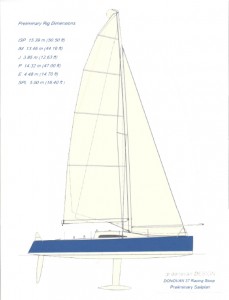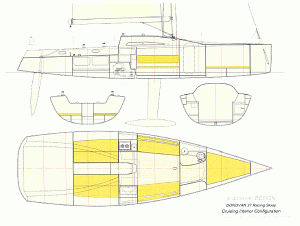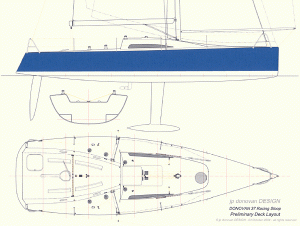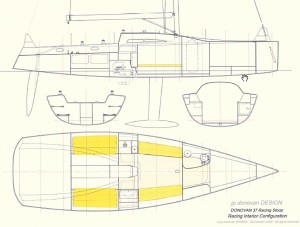Donovan 37: The return of C&C Custom Yachts
Donovan 37 Racing Yacht introduced and built by C&C Custom Yachts
 The Donovan 37 was inspired by sailors who have recognized the Transpac 52 as the style of outstanding racing yacht they want to own. Wouldn't it be great to have something similar but in a more reasonable size?
The Donovan 37 was inspired by sailors who have recognized the Transpac 52 as the style of outstanding racing yacht they want to own. Wouldn't it be great to have something similar but in a more reasonable size?
To provide similar sailing excitement at a fraction of the cost of a Transpac 52, JP Donovan Design, C & C Custom Yachts and Novix Composites Ltd. have developed a 37 foot LOA high performance sailing yacht that shares the same design concepts. In a remarkably simple package utilizing proven high-tech construction methods, uncomplicated state-of-the-art appendage and rig systems, and intelligent deck and interior design, the Donovan 37 is perfectly adapted for the wide spectrum of inshore and offshore racing venues.
The new Donovan 37 design is the successful integration of detailed design analysis and years of experience designing and building performance racing yachts/
C & C Yachts began with the conception of the most high-tech racing yacht of the time, the balsa-cored Red Jacket. For many years, the custom division of C & C produced exceptional racing yachts during the heyday of IOR and the SORC. Although dormant during recent years, C & C Custom Yachts is back and the Donovan 37 will provide the catalyst for re-introduction of the division.
Designer's Comments: James Donovan - JP Donovan Design
The Donovan 37 was inspired by sailors who have recognized the Transpac 52 as the kind of outstanding racing yacht they want to own, but don't want the expense of buying and campaigning a 52 foot racing yacht.
Wouldn't it be great to have something similar but in a more reasonable size? To provide similar sailing excitement at a fraction of the cost of the Transpac 52, I've developed a 37 foot LOA high performance sailing yacht that shares the same design concepts. Most sailors feel that a 37 footer is large enough to safely venture offshore, with enough interior volume for a reasonably comfortable accommodation. In a remarkably simple package utilizing proven high-tech construction methods, uncomplicated state-of-the-art appendage and rig systems, and intelligent deck and interior design, the Donovan 37 is perfectly adapted for both inshore and offshore racing venues.
To provide similar sailing excitement at a fraction of the cost of the Transpac 52, I've developed a 37 foot LOA high performance sailing yacht that shares the same design concepts. Most sailors feel that a 37 footer is large enough to safely venture offshore, with enough interior volume for a reasonably comfortable accommodation. In a remarkably simple package utilizing proven high-tech construction methods, uncomplicated state-of-the-art appendage and rig systems, and intelligent deck and interior design, the Donovan 37 is perfectly adapted for both inshore and offshore racing venues.
The completely new Donovan 37 will provide the yacht so many sailors have been looking for. A real racing yacht with remarkable performance in all wind conditions. This superior design is achieved through a careful analysis and considerable experience in the design and construction of high performance racing yachts.
Hull Design
High speed performance requires a light displacement, low wetted surface hull form. VPP and computer modeling of the hydrodynamic characteristics were used to develop a hull form that balances maximum sailing length, low wetted surface and high form stability. The hull lines are carefully shaped to avoid fore and aft trim changes or excessive asymmetry as the yacht heels. This important hull shape consideration allows the helm to remain neutral as the yacht changes heel angle through waves and changing wind speeds. This not only makes for a yacht that has excellent sea-keeping traits and "feels" great to steer, it is also just simply faster.
Computer programs don't exist to describe a hull form that capable of coping with the myriad of sea conditions we sail in. The knowledge to design a yacht hull that is fast through waves, quick to plane, and controllable at high speeds, comes from experience sailing high performance yachts. The Donovan 37 benefits from my yacht design career devoted to both sailing and designing superior light displacement racing yachts.
Structural Design A successful modern racing yacht needs a carefully engineered light weight structure. It is equally important that the yacht is designed and constructed to withstand severe sea and weather conditions. Inshore racing does not guarantee fair weather; ?offshore sailing inevitably delivers sea conditions that will test the most robust structures. Intelligent structural layout, material choices and construction methods achieves a remarkably simple and light weight structure that is incredibly reliable.
A successful modern racing yacht needs a carefully engineered light weight structure. It is equally important that the yacht is designed and constructed to withstand severe sea and weather conditions. Inshore racing does not guarantee fair weather; ?offshore sailing inevitably delivers sea conditions that will test the most robust structures. Intelligent structural layout, material choices and construction methods achieves a remarkably simple and light weight structure that is incredibly reliable.
The Donovan 37 structures are designed in compliance with the ABS Guide for Building and Classing Offshore Racing Yachts. This is the preeminent scantling rule for offshore racing yachts and has an outstanding track record. Special attention has been made to meet compliance with both the IRC Rule and ORC Offshore Special Regulations to allow participation in a wide variety of racing venues.
The hull and deck laminates combine glass/epoxy vacuum molded laminates for high impact resistance and durability, with uni-directional carbon fiber reinforcements for strength and stiffness. The keel attachment is made via an internal socket tied to a massive carbon frame that absorbs all keel and mast compression loads. Particular emphasis is placed on withstanding grounding loads that create the highest load case with a deep fin keel. Extensive use of the latest formulations in toughened adhesive systems insures the best possible bonding of all structural components.
Keel and Rudder Design The yachting world has gone mad for canting keels, multiple daggerboards and rudders. But the complexity of these systems clearly adds weight to the yacht's structure, reducing the available ballast weight which in turn reduces the stability that all this complexity is trying to gain. It's possible to actually degrade the yacht's performance with all of these "innovations". The one clear fact is that these devices really have no place on a class racing yacht, where sailors want their sailing skill to be the deciding factor in winning races. Much simpler appendage solutions can achieve high performance, higher reliability, and lower construction cost.
The yachting world has gone mad for canting keels, multiple daggerboards and rudders. But the complexity of these systems clearly adds weight to the yacht's structure, reducing the available ballast weight which in turn reduces the stability that all this complexity is trying to gain. It's possible to actually degrade the yacht's performance with all of these "innovations". The one clear fact is that these devices really have no place on a class racing yacht, where sailors want their sailing skill to be the deciding factor in winning races. Much simpler appendage solutions can achieve high performance, higher reliability, and lower construction cost.
The Donovan 37 uses an AC yacht inspired keel fin/bulb design for exceptionally high stability. Taking a similar design approach that aeronautical engineers use to design performance aircraft wings, the steel fin has been carefully engineered to determine the ideal material properties required for an optimized foil design. Precise foil shaping to modified NACA section shapes yields excellent performance characteristics in all conditions.
The keel bulb is cast lead in an elegant shape for low drag - it just looks "right". Similar in shape to the fastest bulbs found on AC yachts, it has been modified to suit a yacht with much higher speed potential. Light displacement designs need high stability for performance and controllability in higher wind strengths. The fin and bulb account for 49% of the yacht's weight, 80% of this ballast is concentrated in the bulb nearly 8 feet below DWL.
The rudder also plays a significant role in assisting the keel to reduce leeway, and the rudder blade span (vertical length) is as long as the keel fin. This large rudder also provides excellent maneuverability on the race course and is an important asset for controlling the yacht at high speed. Foil shape is a proven design that avoids stalling at high rudder angles.
Sailplan and Rig
A benefit of a light displacement yacht is that the rig can be sensibly sized and still provide plenty of power for high speed performance. A high aspect ratio, full battened mainsail and 105% LP genoas provide ample horsepower for the majority of upwind sailing. Masthead spinnakers on a 5 meter (16.4 ft) long spinnaker pole deliver speeds exceeding 20 knots on the downwind legs. For light air upwind and reaching, a masthead genoa may be hoisted for a dramatic increase in performance.
A single swept spreader mast, without running backstays is the simplest, with the fewest number of components (things that can go wrong). In short, this is about the most reliable rig available. Novis Composites is supplying a specially engineered carbon fiber mast section, boom, carbon spinnaker pole, and full rigging package.
My experience designing and constructing America's Cup yacht masts has given me valuable experience and knowledge of engineering carbon mast for racing yachts, and I will work closely with Novis Compsites to develop the design that precisely tuned to this yacht.
Preliminary Specifications
| LOA | 11.45 m | 37.57 ft |
| LWL | 10.00 m | 32.81 ft |
| Beam | 3.45 m | 11.25 ft |
| Draft | 2.45 m | 8.04 ft |
| Displacement (IRC) | 3200 kg | 7250 lbs |
| Ballast 1560 kg | 3440 lbs |
Rig Dimensions
| ISP | 15.39 m | 50.50 ft |
| IM | 13.46 m | 44.16 ft |
| J | 3.85 m | 12.63 ft |
| P | 14.32 m | 47.00 ft |
| E | 4.48 m | 14.70 ft |
| SPL | 5.00 m | 16.40 ft |
Contact Information:
C & C Custom Yachts
Michael Tamulaites
t: 401-396-9300
c: 440-840-5855
[email protected]
JP Donovan Design
James Donovan
c: 410-212-6114
[email protected]
Novis Composites Ltd.
David Hulse
t: 704-658-9258
c: 704-658-8277
[email protected]












